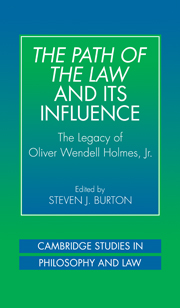Book contents
- Frontmatter
- Contents
- Acknowledgments
- List of Contributors
- The Path of the Law and Its Influence
- Introduction
- 1 Law as a Vocation: Holmes and the Lawyer's Path
- 2 The Bad Man and the Good Lawyer
- 3 Why Practice Needs Ethical Theory: Particularism, Principle, and Bad Behavior
- 4 Theories, Anti-Theories, and Norms: Comment on Nussbaum
- 5 Traversing Holmes's Path toward a Jurisprudence of Logical Form
- 6 Holmes on the Logic of the Law
- 7 Holmes versus Hart: The Bad Man in Legal Theory
- 8 The Bad Man and the Internal Point of View
- 9 Oliver Wendell Holmes, Jr., and William James: The Bad Man and the Moral Life
- 10 Emerson and Holmes: Serene Skeptics
- 11 The Path Dependence of the Law
- 12 Changing the Path of the Law
- 13 Holmes, Economics, and Classical Realism
- 14 Comment on Brian Leiter's “Holmes, Economics, and Classical Realism”
- Appendix: The Path of the Law
- Index
8 - The Bad Man and the Internal Point of View
Published online by Cambridge University Press: 22 October 2009
- Frontmatter
- Contents
- Acknowledgments
- List of Contributors
- The Path of the Law and Its Influence
- Introduction
- 1 Law as a Vocation: Holmes and the Lawyer's Path
- 2 The Bad Man and the Good Lawyer
- 3 Why Practice Needs Ethical Theory: Particularism, Principle, and Bad Behavior
- 4 Theories, Anti-Theories, and Norms: Comment on Nussbaum
- 5 Traversing Holmes's Path toward a Jurisprudence of Logical Form
- 6 Holmes on the Logic of the Law
- 7 Holmes versus Hart: The Bad Man in Legal Theory
- 8 The Bad Man and the Internal Point of View
- 9 Oliver Wendell Holmes, Jr., and William James: The Bad Man and the Moral Life
- 10 Emerson and Holmes: Serene Skeptics
- 11 The Path Dependence of the Law
- 12 Changing the Path of the Law
- 13 Holmes, Economics, and Classical Realism
- 14 Comment on Brian Leiter's “Holmes, Economics, and Classical Realism”
- Appendix: The Path of the Law
- Index
Summary
Before H. L. A. Hart, every major figure in the legal-positivist tradition subscribed to a sanction-centered theory of law. Famously, John Austin conceived of legal rules as threats backed by sanctions, and he viewed statements of legal obligations as predictions that the threatened sanctions would be carried out. Although Hans Kelsen sought to explain legal rules and obligations in terms of norms, these norms were understood to be directives to courts requiring that sanctions be applied. Adopting a hybrid position, Alf Ross understood legal rules as norms addressed to courts directing the use of sanctions, and he understood statements of legal validity as predictions that these norms would be followed.
In The Concept of Law, Hart showed that sanction-centered accounts of every stripe ignore an essential feature of law. This feature he termed “the internal point of view.” Seen from the internal point of view, the law is not simply sanction-threatening, -directing, or -predicting, but rather obligation-imposing.
Though the internal point of view is perhaps Hart's greatest contribution to jurisprudential theory, this concept is also often and easily misunderstood. It is commonly thought that the internal point of view is synonymous with the “insider's” point of view. According to Stephen Perry, “[T]he general idea of the internal point of view is that an adequate jurisprudential account must at some point take into consideration how the practice looks to at least some of the practice's participants, from the inside.”
- Type
- Chapter
- Information
- The Path of the Law and its InfluenceThe Legacy of Oliver Wendell Holmes, Jr, pp. 197 - 210Publisher: Cambridge University PressPrint publication year: 2000
- 7
- Cited by



